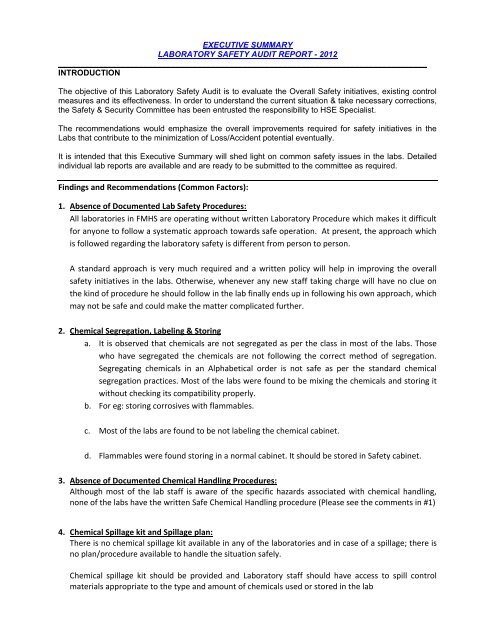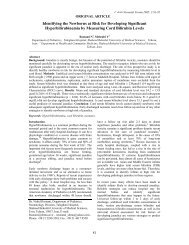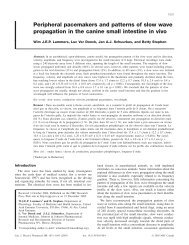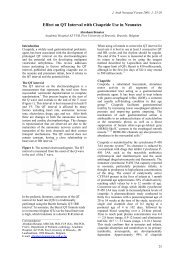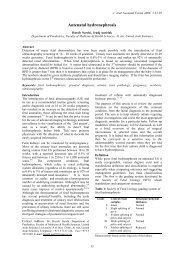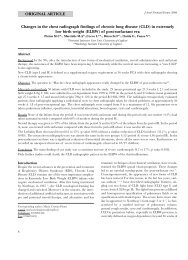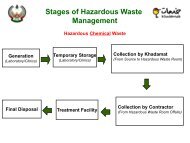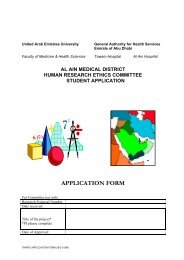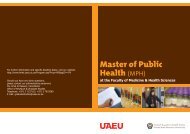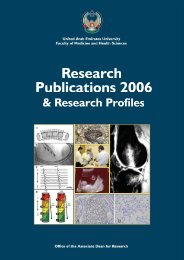Lab Safety Audit Report & progress
Lab Safety Audit Report & progress
Lab Safety Audit Report & progress
You also want an ePaper? Increase the reach of your titles
YUMPU automatically turns print PDFs into web optimized ePapers that Google loves.
EXECUTIVE SUMMARY<br />
LABORATORY SAFETY AUDIT REPORT - 2012<br />
__________________________________________________________________________________<br />
INTRODUCTION<br />
The objective of this <strong>Lab</strong>oratory <strong>Safety</strong> <strong>Audit</strong> is to evaluate the Overall <strong>Safety</strong> initiatives, existing control<br />
measures and its effectiveness. In order to understand the current situation & take necessary corrections,<br />
the <strong>Safety</strong> & Security Committee has been entrusted the responsibility to HSE Specialist.<br />
The recommendations would emphasize the overall improvements required for safety initiatives in the<br />
<strong>Lab</strong>s that contribute to the minimization of Loss/Accident potential eventually.<br />
It is intended that this Executive Summary will shed light on common safety issues in the labs. Detailed<br />
individual lab reports are available and are ready to be submitted to the committee as required.<br />
Findings and Recommendations (Common Factors):<br />
1. Absence of Documented <strong>Lab</strong> <strong>Safety</strong> Procedures:<br />
All laboratories in FMHS are operating without written <strong>Lab</strong>oratory Procedure which makes it difficult<br />
for anyone to follow a systematic approach towards safe operation. At present, the approach which<br />
is followed regarding the laboratory safety is different from person to person.<br />
A standard approach is very much required and a written policy will help in improving the overall<br />
safety initiatives in the labs. Otherwise, whenever any new staff taking charge will have no clue on<br />
the kind of procedure he should follow in the lab finally ends up in following his own approach, which<br />
may not be safe and could make the matter complicated further.<br />
2. Chemical Segregation, <strong>Lab</strong>eling & Storing<br />
a. It is observed that chemicals are not segregated as per the class in most of the labs. Those<br />
who have segregated the chemicals are not following the correct method of segregation.<br />
Segregating chemicals in an Alphabetical order is not safe as per the standard chemical<br />
segregation practices. Most of the labs were found to be mixing the chemicals and storing it<br />
without checking its compatibility properly.<br />
b. For eg: storing corrosives with flammables.<br />
c. Most of the labs are found to be not labeling the chemical cabinet.<br />
d. Flammables were found storing in a normal cabinet. It should be stored in <strong>Safety</strong> cabinet.<br />
3. Absence of Documented Chemical Handling Procedures:<br />
Although most of the lab staff is aware of the specific hazards associated with chemical handling,<br />
none of the labs have the written Safe Chemical Handling procedure (Please see the comments in #1)<br />
4. Chemical Spillage kit and Spillage plan:<br />
There is no chemical spillage kit available in any of the laboratories and in case of a spillage; there is<br />
no plan/procedure available to handle the situation safely.<br />
Chemical spillage kit should be provided and <strong>Lab</strong>oratory staff should have access to spill control<br />
materials appropriate to the type and amount of chemicals used or stored in the lab
5. Material <strong>Safety</strong> Data Sheet:<br />
Majority of the labs are not maintaining the Material <strong>Safety</strong> Data Sheet in their respective<br />
laboratories.<br />
Hard copy of all the MSDS have to be made available all the time in the <strong>Lab</strong>. Keeping the soft copy of<br />
the MSDS is not recommended as it could be difficult to get it in case of computer hard disk or<br />
network failure.<br />
6. Keeping Excessive Quantity of chemicals<br />
It is observed that number of <strong>Lab</strong>oratories are keeping at least 6 months stock of chemicals<br />
(flammables, corrosives, solids etc) due to the immense delay in getting it. Currently the<br />
procurement process is lengthy and hence, the chemical procurement is delayed immensely. This has<br />
prompted the lab to keep big quantity as a stock.<br />
This poses a big risk as most of the labs are facing space/store shortage issue. Accumulating<br />
hazardous chemicals in bulk quantity is really matter of concern as the condition & kind of facility<br />
inside the store to keep such quantity poses enormous risk.<br />
7. Personal Protective Equipment (PPEs)<br />
a. It is observed that most of the labs are not using the PPEs (lab coats, gloves, goggles etc) all<br />
the time due to the reason that there is no standard lab safety policy available to follow<br />
uniformly.<br />
b. Most of the labs do not have stock of appropriate personal protective equipment such as<br />
goggles, respiratory protections, gloves for different kind of chemicals etc.<br />
<br />
<br />
This matter should be given utmost priority and strictly be implemented as it could pose a<br />
real threat to individuals’ health in the long run. <strong>Lab</strong> safety training should be provided to all<br />
laboratory staff to create awareness on lab safety and best practices.<br />
Review & assess the requirements and quantity of PPE’s for each lab by the department head<br />
and procure as per the individual lab requirements (eye wash, eye protection equipment,<br />
special hand gloves, etc).<br />
8. Eye Wash Solution Kit:<br />
Most of the laboratories Eye wash solution kit was found to be empty.<br />
A new set of Eye wash solution kit has to be provided. It should be filled regularly to ensure that the<br />
solution is available in case of emergency.<br />
9. Fire Extinguisher:<br />
Fire Extinguisher is not provided to all the labs. Many labs are yet to have the fire extinguishers.<br />
Fire extinguisher has to be provided and it is highly recommended to mount it on the wall as it will be<br />
easier to locate and handle it.
10. Lack of awareness about emergency evacuation<br />
Currently, majority of the lab staff do not have any information about the emergency evacuation<br />
procedures, Emergency contact number for reporting an incident, location of the assembly area and<br />
their individual responsibilities during emergency situation.<br />
<br />
An emergency awareness training to has to be provided to all staff as soon as possible.<br />
<br />
<strong>Lab</strong>oratory emergency contacts and specific laboratory hazards must be posted at the<br />
principal entrance to each laboratory, for emergency response personnel use.<br />
<br />
Posting of evacuation routes is recommended as a part of the Emergency Action Plan.<br />
11. Storage space for the labs<br />
a. Some of the labs have pointed out that they are in short of place for storing their chemicals &<br />
consumable items as few of the stores which they used in the past is now converted in to labs<br />
which is prompting them to store bulk quantity of chemicals and consumables in the lab itself.<br />
b. It is observed that some of the labs are showing tendency to keep the outdated/obsolete<br />
equipment in the lab even though they are of no use. It is noticed that most of the items are<br />
kept it just because it is recorded against individual name or they are unaware about the correct<br />
hand over procedures.<br />
c. Some of the labs are not utilizing their space efficiently and found to be unarranged<br />
<br />
It is recommended to provide a central store which should be shared between the labs and<br />
individual cabinets (with lock) should be provided to each lab to avoid mix up.<br />
<br />
It is recommended to send the obsolete items to central store and hand over officially.<br />
It is recommended to rearrange the lab as much as possible/reasonably well to have more<br />
space.<br />
12. Carton boxes<br />
Most of the labs were found to be storing a lot carton boxes, both light and heavy on the top of the<br />
cabinets.<br />
Heavy Carton boxes have to be removed from the top and stored in a store room or any available<br />
free space on the floor.<br />
13. Absence of <strong>Safety</strong> posters<br />
None of the labs have safety warning/caution posters.<br />
In order to create safety awareness, it is imperative that safety information/warning/caution<br />
posters must be posted inside and at the laboratory entrance as required.


